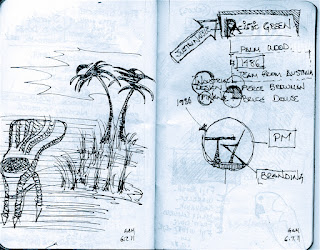OCEANO PACIFICO
"I am a visual man. I watch, I watch, I... I understand things through my eyes."
Henri Cartier-Bresson, LIFE 15.03.1963
Henri Cartier-Brenson, thank you for being such a good travel companion, for your lessons on viewing the world. I truly enjoyed navigating Fiji and the South Pacific with you... where there is space for reflection, contemplation and relaxation in an Ocean of sunny days and starry nights.
Guillermo Aranda-Mena
Domo-Domo [masthead] A massive horned masthead. Comes from the last Ocean going double hulled canoe [outrigger] called the 'Ramarama' a final link in a chain of great druas of the name built for the 'Tui Cakau' by his 'inataitoga', the descendant of a chain of samoan canoe builders (Lemaki) whi were brought to Fiji from Tonga in the late nineteen century (1872-1877). The main hull of the Ramarama was 30.18 mts and the Domo-Domo 4.32 mts high.
Suva Museum, Fiji 16.7.2011
 |
Fiji [Viti] "If every single island were counter, the isles of the Fiji archipelago would number in the thousands. A mere 322 are judged large enough for human habitation, however, and of these only 106 are inhabited. That leaves 216 uninhabited islands, most of them prohibitively isolated or lacking fresh water. "
Stanley, D. 1996 South Pacific. Moon Pubs.
"Photographs vs Drawings: Photography is an immediate reaction. Drawing a meditation. I have simply changed instruments but it is the view that counts"
Henri Cartier-Bresson 1992
"If in my photographs it rarely happens that I show man-made things - like skyscrapers, or bridges - it is not because I don't appreciate their beauty and grandeur, but quite simply because [...] I am more interested in human beings and their place in society than in material structures."
HCB, typescript of 1947 for an unpublished book.
First Landing: The legend recalls a canoe called the Kauniton came from the west bringing the first Fijians to these islands centuries ago. The canoe hit the reef of this beach called Nalamu meaning 'pierce'. According to oral traditions, the first Melanesian setlers landed at Vuda Point and stablished Viseisei.
"Ideally, on my travels I would like to have gone round on a motorbike in order to be closer to people and landscapes. And so I alternated between the car, driven by Dominique Pail-Bouncourt, and going on foot. You have to be an inveterate pedestrian to see things."
HCB, Les Nouvelles littéraires 1970
"Filmmaking: another way of seeing. In the mid-1930s, early in his career, Henri Cartier-Bresson is believed to have considered giving up photography in order to concentrate on the cinema. While this did not happen in the end, filmmaking nonetheless became a small but vital part of his artistic output."
HCB in Clément Chéroux, 2008 Thames&Hudson p.p. 130
"Colour in photography is based on a elementary prism [...] and for the moment it cannot be otherwise, as no one has yet discovered the chemical processes that would allow the immensely complex decomposition and recomposition of colour (in pastel, there are for example, 375 different shades of green!) For colour is a very important means of conveying information, but it is very limited at the level of reproduction, which remains chemical, not transcendental and intuitive, as it is in painting. In contrast to black, which covers the most complex range, colour offers only a totally fragmented range."
"...only shopkeepers and magazines are seduced by the color photo"
HCB interview for Le Monde, Sept 1974.
FIJI: It was great to be back.
Link to FIJI blogpost: August 2009
Saludos, Guillermo [email]
________________________________________
Comments:
Guillermo hola,
Welcome back to our civilization. Your travel notes deserve to be published one day. I’m impressed by your acute observations. I’ve committed myself to seeing 13 movies during the next 2 weeks (Melbourne International Film Festival (MIFF). Of course, MIFF will not entirely occupy the next 2 weeks. Give me a bell.
Ciao (what’s Spanish for ‘ciao’?)
Alex.
_______________________________________
Carissimo Guillermo,
I hope you survived your first day back into civilization.
I am happy to hear that HCB has accompanied you along your exploration of South Pacific. His first wife was from Java, so it suits.
I like the sentences that you quoted. In the exhibition there was a documentary video, a kind of a long interview and there, too, he mentioned that thing about photography = immediate reaction vs. drawing = meditation ... which maybe also explains why I am so fascinated by your sketches and by pictures of you drawing.
At some point the video showed HCB in the Louvre in front of this painting by Paolo Uccello.
I hope you survived your first day back into civilization.
I am happy to hear that HCB has accompanied you along your exploration of South Pacific. His first wife was from Java, so it suits.
I like the sentences that you quoted. In the exhibition there was a documentary video, a kind of a long interview and there, too, he mentioned that thing about photography = immediate reaction vs. drawing = meditation ... which maybe also explains why I am so fascinated by your sketches and by pictures of you drawing.
At some point the video showed HCB in the Louvre in front of this painting by Paolo Uccello.
 |
Paolo Uccello, "La Battaglia di San Romano", a triptych, now split up among the Louvre, London's National Gallery and gli Uffizi. |
After having gazed at it for some time, he said: "What can you do after something like that? Just get really badly drunk." It was also funny that he mentioned that he had recently been at the opening of an exhibition and that there he had observed people's (especially women's) legs and had thought about the legs in this painting.
I've got mail! My dear friend Robinson Crusoe has sent me a breathtaking postcard from his Fiji island:
thak you so much! ;-*
Have a great week.
Un sacco di baci
Carla














































